Mary (Mother Of Jesus)
 From Nwe
From Nwe 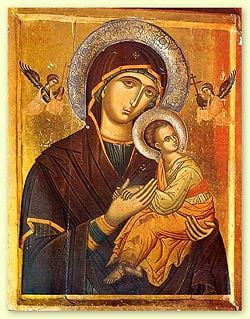
(Saint Catherine's Monastery, Mount Sinai, Egypt, sixteenth century)
Mary (מרים, Maryām, "Bitter") was the mother of Jesus Christ. Tradition names her parents as Joachim and Anne. According to the New Testament, she was the betrothed wife of Joseph (Matt 1:18-20, Luke 1:35) but conceived Jesus miraculously through the Holy Spirit without her husband's involvement.
Although she does not seem to have supported Jesus' public ministry, Mary was present at the crucifixion and is depicted as a member of the early Christian community in Jerusalem. Christian churches teach various doctrines concerning Mary, and she is venerated in the Catholic and Orthodox traditions. Several Protestant denominations, however, question or even condemn such devotional and doctrinal attitudes.
Mary is the most prominent female figure in Christianity and is considered by millions to be the most meritorious saint of the church. She is said to have miraculously appeared to believers many times over the centuries. Mary (Mariam or Maryam) also has a revered position in Islam, where a whole chapter is devoted to her. In Unification tradition, she is recognized as a key player in God's providential history and is respected for risking her life in conceiving Jesus without her husband's protection, but is criticized for failing understand her proper role to support Jesus adequately.
Mary in the New Testament
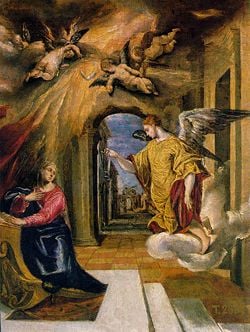
Mary was a relative of Elizabeth, wife of the priest Zechariah, who herself was of the lineage of Aaron (Luke 1:5; 1:36). Mary resided at Nazareth in Galilee while betrothed to Joseph of the House of David (Luke 1:26). During their betrothal—the first stage of a Jewish marriage—the angel Gabriel announced to her that she was to become the mother of the promised Messiah.
He will be great and will be called the Son of the Most High. The Lord God will give him the throne of his father David, and he will reign over the house of Jacob forever; his kingdom will never end (Luke 1:32-33).
Asking how this could be since "I have known no man," Mary was told about Elizabeth's miraculous conception and informed that the "power of the Most High will overshadow you." (Luke 1:35). Mary immediately left for Zechariah's house, where she was greeted prophetically by Elizabeth and remained for three months. Matthew's gospel tells us that Joseph intended to divorce her when he learned of her pregnancy. However, an angel informed him in a dream to be unafraid and take her as his wife, because her unborn child is "from the Holy Spirit" (Matthew 1:18-25).
According to the Gospel of Luke, a decree of the Roman emperor Augustus (Luke 2:1) required that Joseph and his betrothed should proceed to Bethlehem for an enrollment. While they were there, Mary gave birth to Jesus; but because there was no place for them in the inn, she had to use an animal manger as a crib.
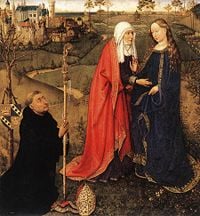
After eight days, the boy was circumcised and named Jesus. These customary ceremonies were followed by Jesus' presentation at the Temple of Jerusalem in accordance with the law that firstborn males must been redeemed. The Gospel of Matthew adds the visit of the Magi and the family's flight into Egypt, while Luke portrays them as returning to Nazareth without any mention of Egypt. In Matthew's account, they return to Nazareth after the death of King Herod the Great about 2/1 B.C.E.(Matthew 2). Mary apparently remained in Nazareth with her family thereafter. Mark 6:3 refers to Jesus having four brothers (James, Joseph, Simon and Judas) and at least two unnamed sisters, although traditions differ as to whether these are Mary's children, the children of a previous marriage of Joseph, or perhaps cousins.
Little is said of Mary's relationship with Jesus during his infancy and youth. However, one dramatic event is portrayed when Jesus was 12 years old. Jesus separated from his parents and remained in Jerusalem without their knowledge after a Passover pilgrimage to the holy city.
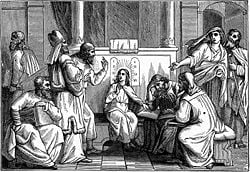
His family left for Nazareth and—thinking he was in another part of their caravan—only began to look for him after a day's journey, finally returning to Jerusalem and discovering him after three days. Jesus had been in the Temple courtyards among the teachers, hungrily "listening to them and asking questions." Luke adds that "everyone who heard him was amazed at his understanding and his answers" (Luke 2:41-52). However, when Mary arrived at the scene she scolded him, demanding, "Why have you treated us like this?" Jesus replied, "Didn't you know I had to be in my Father's house?" Mary and Joseph promptly ended his dialog with the teachers and took him back to Nazareth.
Luke indicates that Jesus was "obedient" to his parents thereafter, but nothing else appears in this record about their relationship until after Jesus began his public ministry, at age 30. Most readers assume that sometime in the intervening period, Mary was widowed, for Joseph is not mentioned again.
In John's gospel, Mary occasioned Jesus' first miracle at the marriage in Cana when she informed him that the hosts have run out of wine. Jesus' response to her request was: "Woman, what have I to do with thee? Mine hour is not yet come." Nevertheless, he satisfied her complaint by turning water into wine (John 2:1-11).
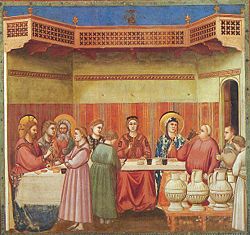
If a strained relationship between mother and son is only hinted at here, it is openly described in a later episode in all three synoptic gospels. Mark's account, thought to be the earliest, explains that Mary and Jesus' brothers had come "to take charge of him, for they said, 'He is out of his mind.'" Jesus rejected them, famously saying: "Who are my mother and my brothers? … Here are my mother and my brothers! Whoever does God's will is my brother and sister and mother" (Mark 3:21-34).
Mary apparently remained uninvolved in supporting Jesus' ministry. Jesus hinted at continued estrangement from his family in teaching his disciples such principles as: "If anyone comes to me and does not hate his father and mother, his wife and children, his brothers and sisters… he cannot be my disciple" (Luke 14:26).
Nevertheless, Mary is depicted as being present during the crucifixion standing near "the disciple whom Jesus loved" (traditionally John the Beloved), two other women named Mary—Mary Magdalene and the Mary the wife of Clopas (John 19:25-26)—and, in Matthew's account, "the mother of the sons of Zebedee." From the cross, Jesus tells her: "Woman, here is your son," and to the disciple, "Here is your mother."
Thereafter, Mary became associated with the community of disciples in Jerusalem. She is the only woman mentioned by name as being present at the election of Matthias to replace Judas as one of the 12 apostles (Acts 1:12-26). This, however, is her last appearance in the New Testament accounts and her death is unrecorded.
Other ancient sources
Non-Christian sources
Celsus, a late second-century Greek philosopher and polemical writer against Christianity, claimed that Jesus was an illegitimate child of a certain Roman soldier named Panthera, and that Mary had been turned out by her husband because she was convicted of unfaithfulness (Origen, Contra Celsum 1:28-32). These claims are related to the references in the Talmud to the figure of Ben-Pandera as Jesus' supposed father. According to the early third-century Acts of Pilate, a apocryphal Christian work, the elders of the Jews stated to Pilate during the trial of Jesus that he had been conceived through fornication.[1]
Later Christian writings and traditions

According to the apocryphal Infancy Gospel of James, Mary was the daughter of Joachim and Anna. Before Mary's conception, Anna had been barren, and her parents were quite old when she was conceived. They dedicated her to lifelong service as a consecrated virgin in the Temple of Jerusalem when she was three years old, much as the prophet Samuel was devoted to God at the tabernacle by his mother, Hannah. There, she is selected for the honor of sewing a new curtain for the temple at the same time that Zechariah receives his vision from the angel Gabriel concerning the birth of John the Baptist. Mary presents her sewing to the high priest after the Annunciation, before continuing on to Zechariah's house. After the birth of Jesus, her virginity is dramatically re-affirmed.[2]
According to Eastern Orthodox tradition, Mary died either in Jerusalem or Ephesus, surrounded by the apostles. Later, when the apostles opened her tomb, they found it empty, and they concluded that she had been bodily assumed into Heaven. "Mary's Tomb" in Jerusalem is traditionally attributed to Mary, but it was unknown until the sixth century. The House of the Virgin Mary near Ephesus, Turkey, is believed by some to be the place where Mary lived in later life with the apostle John.
Titles given to Mary

Mary's most common titles include “The Blessed Virgin Mary,” “Our Lady” (Notre Dame, Nuestra Señora, Nossa Senhora, Madonna), “Mother of God,” and the “Queen of Heaven.”
Mary is frequently referred to by the Eastern Orthodox Church and related traditions as Theotokos, meaning "God-bearer," a title recognized at the Third Ecumenical Council, held in 431 C.E. at Ephesus, against the teachings of Nestorius. The name was used theologically to emphasize that Mary's child, Jesus Christ, was in fact fully God as well as fully man.
Mary in the Qur'an
And We Made the son of Mary and his mother a Sign …. (Q23.50)
Mary, mother of Jesus, enjoys a distinguished and honored position in the Qur'an, which relates detailed narrative accounts of "Maryam" in two places: 3:35-47 and 19:16-34. Juan Galvan explains the role of Jesus' mother Mariam, in Islam for Today.[3]
She is the only woman directly designated in the book to be an Ayat Allah or "Sign of The God" to mankind (23.50). She is described as one who "guarded her chastity" (66.12), as an "obedient one" (66.12), the "chosen of her mother" dedicated to Allah while still in the womb (3.36), uniquely (among women) "accepted into service by Allah" (3.37), and cared for by one of the prophets, namely Zechariah (3:37). As per the Infancy Gospel of James, she resided in the Temple of Jerusalem during her childhood and had unique access to the Holy of Holies. She was provided with heavenly gifts by Allah (3:37). She is called "Chosen One" (3.42), a "Purified One" (3.42), a "Truthful one" (5.75), a "fulfillment of prophecy" (66.12), and a "vessel for the Spirit of God" (66.12). She was "exalted above all women of The Worlds" (3.42).
The Qur'an also affirms the virgin birth of Jesus:
When the angels said "O Mary! Allah Gives thee Good News of a son through a Word from Him! His name shall be the Messiah, Jesus son of Mary, honored in this world and in the next, and of those who Are Granted Nearness to Allah!" (3.45)
She said "My Lord! How shall I have a son when no man has touched me?" He Said, "That is as it shall be. Allah Creates what He Pleases. When He decrees a thing. He says to it "Be" and it is!" (3.47)
Marian Doctrines
Immaculate Conception of Mary
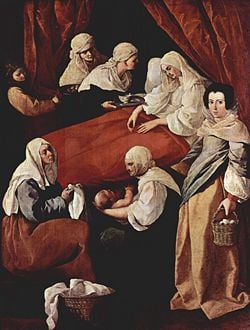
The Immaculate Conception is the doctrine that states that Mary herself was conceived and born free of original sin. Only the Roman Catholic Church has officially adopted this teaching, and the title "Immaculate Conception" is one used only by Roman Catholics and those members of the Anglican Communion who describe themselves as "Anglo-Catholic."
Eastern Orthodox Christians tend to reject the Immaculate Conception. The Orthodox believe that Mary was conceived like any one else, but was cleansed from the original sin when Christ took form within her. Most Protestants likewise reject the idea that Mary was without original sin, believing that she had to accept Jesus and be baptized in order to receive salvation, like any other person.
The Roman Catholic Church observes the Feast of the Immaculate Conception on December 8. The Orthodox Church observes the Feast of the Conception by Mary's mother, Saint Anna of the Most Holy Theotokos, on December 9.
Virgin Birth of Jesus
The Apostles' Creed and Nicene Creed both refer to Jesus as born to "the Virgin Mary." This alludes to the belief that Mary conceived Jesus through the Holy Spirit, and not through sexual intercourse. That she was a virgin at this time is affirmed by Eastern Christianity, Roman Catholicism and many (but not all) Protestants.
The Gospel of Matthew describes Mary as a virgin who fulfilled the prophecy of Isaiah 7:14. Opponents point out that the Hebrew word almah that appears in this verse means "young woman," not "virgin." Jews, moreover, affirm that the prophecy was fulfilled long ago, referring not to the Messiah, but to a boy called Immanuel who lived in the time of king Ahaz of Judah: "Before the boy knows enough to reject the wrong and choose the right, the land of the two kings that you (Ahaz) dread will be laid waste" (Isaiah 7:16).
However, regardless of the meaning of this verse, it is clear that the authors of the gospels of Matthew and Luke assert that Mary had "no relations with man" before Jesus' conception (Matthew 1:18, 25; Luke 1:34). It is commonplace for Christian believers to accept this claim at face value—especially given its theological import that Jesus was literally the "son" of God.
For skeptics and for rational-minded believers who do not accept that God works in ways that are contrary to science—human parthenogenesis is scientifically implausible and has never been observed—the virgin birth is a legend, possibly adopted from the Greek mystery religions of that time: For example, Horus, a major god of the Egyptian mystery religion, was born of the virgin Isis; and Mithra, whose cult rivaled Christianity during the first few centuries of its existence, was conceived when the creator-god, in the form of light, entered a virgin.
Yet the mere fact that the gospels proclaim the virgin birth suggests that there were widespread rumors that Jesus was an illegitimate child—attested to by Mark 6:3 where his neighbors call him the "son of Mary," not the son of Joseph. At this time in Palestine, all children were identified through their [[paternalism|father's lineage.] There is even a Jewish tradition that appears in the Tosefta dated to a period concurrent with or shortly after the redaction of the Mishnah (70-200 C.E.), which asserts that he was fathered by a Roman soldier. These rumors undoubtedly caused many problems for Mary, as well as for Jesus. Would Joseph have easily accepted his mother's explanation, that she became pregnant by the Holy Spirit? The Bible says that Joseph was warned by an angel, but for Mary, as she traveled back to Nazareth, alone and pregnant, to meet Joseph, her heart must have been filled with trepidation. If he rejected her, her life would be ruined, and the precious child in her womb would have no protector. Even though Joseph accepted her, the relationship between Mary and Joseph may have suffered as the child that was not his grew older, and particularly as they had more children for whom parentage was not at issue. Jesus remarked, "A prophet is not without honor, except… in his own house" (Mark 6:4). He became an outcast even in his own home.
For those seeking a natural or biological explanation, candidates for Jesus' human father include the priest Zechariah, in whose house Mary lived for three months before her pregnancy became known (Luke 1:40, 56). If Mary had been directed by the angel to Zechariah's bed to perform a divine errand, the child might well have been thought of as born "of the Holy Spirit." Zechariah's total silence (he was struck dumb) adds to the mystery of her pregnancy. After he accepts the name John for his son, Zechariah and Elizabeth are never again mentioned in the New Testament. The traditional Christian view is that Mary was made to conceive by the Holy Spirit in Nazareth at the time of the angel's announcement, before she departed for Zechariah's house.
Perpetual virginity
That Mary remained a virgin after the birth of Jesus is a doctrinal stance of the Catholic, Eastern, and Oriental Orthodox churches. The issue of Mary's perpetual virginity is related to the interpretation of the New Testament references to the siblings of Jesus. Those who defend the doctrine point out that Aramaic, the language spoken by Christ and his disciples, lacked a specific word for "cousin," so that the word "brother" was used instead. Others argue that Jesus' "brothers" and "sisters" were sons of Joseph by a previous wife, and thus Jesus' stepbrothers.
Two of the most prominent leaders of the Reformation, Martin Luther and Ulrich Zwingli also defended the perpetual virginity of Mary against those who questioned the teaching. Further, John Calvin argued against the necessity of seeing Jesus' "brothers" as Mary's sons. By the seventeenth century, the Catholic and Protestant churches came to see Mary as a major point of division.[4] Most Protestants today reject the doctrine of Mary's perpetual virginity.
Assumption
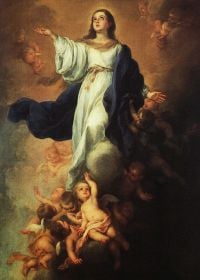
The term "assumption" is distinguished from "resurrection." In the case of resurrection, the spirit separates from the body and ascends first to heaven while the body rises from the dead later. In "assumption," body and spirit ascend as one. The belief in the assumption of Mary was formally declared to be dogma by Pope Pius XII in 1950. He stated in Munificentissimus Deus:
The Immaculate Mother of God, the ever Virgin Mary, having completed the course of her earthly life, was assumed body and soul into heavenly glory. Hence if anyone, which God forbid, should dare willfully to deny or to call into doubt that which we have defined, let him know that he has fallen away completely from the divine and Catholic Faith.
In the Eastern Orthodox tradition, Mary, the Theotokos, seemed to die normally but was soon found to have ascended. Eleven of the apostles were present and conducted the funeral. The apostle Thomas, however, was delayed and arrived a few days later. The tomb was opened so that Thomas could venerate the body; however the body had mysteriously vanished. It was their conclusion that she had been taken, body and soul, into heaven. While virtually every Orthodox Christian believes this to be true, the Orthodox have never formally made it a dogma. The Eastern Orthodox celebrate this event on the August 15. The Oriental Orthodox celebrate it on August 22.
Optional feast days such as the Assumption (August 15) are celebrated by some Anglicans. Most Anglicans, however, hold that Mary died and that after her death, her soul was transported to heaven without her body. Churches of the Anglican Communion celebrate the Purification of Saint Mary the Virgin (February 2) and the Annunciation of the Blessed Virgin Mary (March 25) as principal feasts of the Church. The Church of England requires that Holy Communion be celebrated in every parish church on these two feasts.
Christian Veneration of Mary
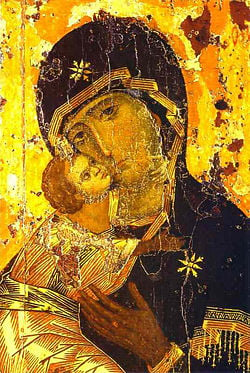
Roman Catholic, Orthodox and some Anglican Christians venerate Mary, as do the non-Chalcedonian or Oriental Orthodox, a communion of churches that has been traditionally deemed monophysite (such as the Coptic Orthodox Church). This veneration especially takes the form of prayer for intercession with her Son, Jesus Christ. Additionally it includes composing poems and songs in Mary's honor, painting icons or carving statues representing her, and conferring titles on Mary that reflect her position among the saints. She is perhaps the most highly venerated saint in both the Roman Catholic and the Eastern Orthodox Church; several major feast days are devoted to her each year.
Protestants have generally paid a relatively small amount of reverence to Mary compared to their Anglican, Catholic, and Orthodox counterparts, often arguing that if too much attention is focused on her, there is a danger of detracting from the worship due to God alone. Some accuse those who venerate Mary of idolatry.
A major theological impetus for the veneration of Mary originated from the Christological controversies of the early church—many debates defining the divinity or humanity of Jesus. Some argued that since Jesus was indeed God, Mary must be the "Mother of God."
However, a real surge in the veneration of Mary took place in the early twelfth century, especially due to the preaching of Bernard of Clairvaux. Bernard expanded upon Anselm of Canterbury's role in transforming the sacramental Christianity of the Early Middle Ages into a new, more personally held faith, with the life of Christ as a model and a new emphasis on the Virgin Mary. In opposition to the rationalist approach adopted by scholasticism, Bernard preached an immediate faith, in which the intercessor was the Blessed Virgin. "The Virgin that is the royal way, by which the Savior comes to us," he declared. Since then, Mary has continued to be a central object of veneration in the Catholic and some Anglican traditions.
On May 16, 2005, the Roman Catholic and Anglican churches issued a joint 43-page statement, “Mary: Hope and Grace in Christ” [5] (also known as the Seattle Statement) on the role of the Virgin Mary in Christianity as a way to uphold ecumenical cooperation despite differences over other matters.
Virgin of Guadalupe

The veneration of Mary is particularly popular in Latin American countries, beginning with the appearance of the "Virgin of Guadalupe" to Juan Diego Cuauhtlatoatzin on the hill of Tepeyac near Mexico City from December 9, 1531 through December 12, 1531. Mainstream Catholics believe that Guadalupe was a manifestation of the Virgin Mary in the Americas, and recognize her as "Empress of the Americas." The Virgin of Guadalupe has also symbolized the Mexican nation since Mexico's War of Independence. Both Padre Miguel Hidalgo and Emiliano Zapata's armies traveled underneath Guadalupan flags, and Nuestra Señora de Guadalupe is generally recognized as a symbol of all Mexicans.
Some historians believe the icon was meant to syncretically represent both Virgin Mary and the indigenous Mexican goddess Tonantzin. Others believe the Virgin was a simplified and sanitized version of Coatlicue, the Aztec mother goddess.
The Basilica of Guadalupe in Mexico City is the most important religious building in Mexico. It houses the original apron of Juan Diego that shows the icon of Our Lady of Guadalupe. Thus it is an important pilgrimage site and is visited by several million people every year.
Appearances
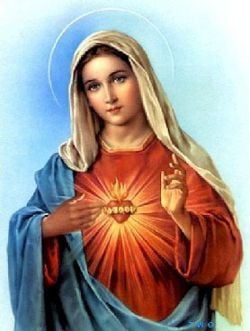
Mary has often appeared to the faithful, including several popes, saints, and everyday people, in recorded visions and revelations from the fourth century onward. Historical records of such Marian apparitions increase dramatically with the advent of the above-mentioned emphasis on the veneration of Mary in the Middle Ages. Some locations where Mary appeared have become important places of pilgrimages for the faithful around the world. In addition to the Basilica of the Virgin of Guadalupe mentioned above, important sites include:
- Appearances of Our Lady of Lourdes to the peasant girl Bernadette Soubirous in the French village of Lourdes, France, in 1858. This site receives millions of visitors each year and a number of miraculous faith healings have been reported there.
- Appearances of Our Lady of Fatima to the young Lucia dos Santos and two other children, in Fátima, Portugal in 1917. These apparitions included several messages recognized as authentic revelations by the Vatican.
- Recent appearances beginning in 1981 in the Bosnia and Herzegovinan, town of Međugorje and other nearby locations to six young Catholics, in which ten "secrets" of future events were revealed. These apparitions are still controversial within the Catholic Church and while some authorities believe in them, they have not been officially accepted.
Other significant appearances include:
- 352—Pope Liberius, in Rome.
- 12??—Saint Bernard of Clairvaux.
- 1214—Saint Dominic of Osma.
- 1513—Juan Diego, a farmer, in Villa Guadalupe, Mexico.
- 1579—Matrona, a ten-year-old girl, Kazan, Russia.
- 1586—María Ramos, a Spanish maid, Chiquinquirá, Colombia
- 1600—Milkman and sailors, Vailankanni, India
- 1634—Mariana de Jésus Torres, Quito, Ecuador
- 1717—A group of fishermen, Aparecida, Brazil
- 1798—A group of persecuted Catholics, La Vang, Vietnam
- 1830—Saint Catherine Labouré, Paris, France
- 1846—Two cowherder children, La Salette, France
- 1850—Peasant herders Mikołaj Sikatka, Licheń Stary, Poland
- 1876—Three eight-year-old girls, Marpingen, Germany
- 1879—Numerous witnesses, Knock, Ireland
- 1900—Peking (Beijing) and Shanghai, China
Numerous additional apparitions of Mary have been reported in during the twentieth and early twenty-first centuries.
See also
- Black Madonna
- Immaculate Conception
- Theotokos
Notes
- ↑ Acts of Pilate, Early Christian Writings. Retrieved August 8, 2007.
- ↑ Infancy Gospel of James, Translated by Andrew Bernhard. Gospels.net. Retrieved August 8, 2007.
- ↑ Juan Galvan, "Jesus and The Virgin Mary in Islam" [1]islamfortoday. Retrieved September 2, 2008.
- ↑ Matthew J. Slick, Did Mary Have Other Children? Christian Apologetics and Research Ministry. Retrieved August 8, 2007.
- ↑ “Mary: Hope and Grace in Christ" full text [2].Anglican Communion.org. Retrieved September 2, 2008
References
ISBN links support NWE through referral fees
- Brownson, Orestes. Saint Worship and the Worship of Mary. Manchester, NH: Sophia Institute Press, 2003. ISBN -928832881
- Cronin, Vincent. Mary Portrayed. London: Darton, Longman & Todd, Ltd., 1968. ISBN 0875052134
- Epie, Chantal. The Scriptural Roots of Catholic Teaching. Manchester, NH: Sophia Institute Press, 2002. ISBN 1928832539
- Graef, Hilda. Mary: A History of Doctrine and Devotion. London: Sheed & Ward, 1985. ISBN 0722052219
- Marley, Stephen. The Life of the Virgin Mary. Harpenden, Harts, UK: Lennard Publishing, 1990. ISBN 978-1852910242
- Miravalle, Mark. Introduction to Mary. Second edition, 2006. Santa Barbara, CA: Queenship Publishing. ISBN 1882972066
- Sirias, Silvio. Bernardo and the Virgin. Evanston, IL: Northwestern University Press, 2005. ISBN 978-0810124271
- Pelikan, Jaroslav. Mary Through the Centuries: Her Place in the History of Culture. New edition, 1998. New Haven, CT: Yale University Press. ISBN 978-0300076615
External links
All links retrieved November 7, 2022.
- The Blessed Virgin Mary – Catholic Encyclopedia
- The son of Mary in Islam – Islam from Inside.com
- “Mary was probably not a virgin,” by Geza Vermes, The Guardian (December 16, 2006)
Credits
New World Encyclopedia writers and editors rewrote and completed the Wikipedia article in accordance with New World Encyclopedia standards. This article abides by terms of the Creative Commons CC-by-sa 3.0 License (CC-by-sa), which may be used and disseminated with proper attribution. Credit is due under the terms of this license that can reference both the New World Encyclopedia contributors and the selfless volunteer contributors of the Wikimedia Foundation. To cite this article click here for a list of acceptable citing formats.The history of earlier contributions by wikipedians is accessible to researchers here:
- Mary (mother of Jesus) history
The history of this article since it was imported to New World Encyclopedia:
- History of "Mary (mother of Jesus)"
Note: Some restrictions may apply to use of individual images which are separately licensed.
↧ Download as ZWI file | Last modified: 02/04/2023 03:29:18 | 217 views
☰ Source: https://www.newworldencyclopedia.org/entry/Mary_(mother_of_Jesus) | License: CC BY-SA 3.0
 ZWI signed:
ZWI signed: KSF
KSF